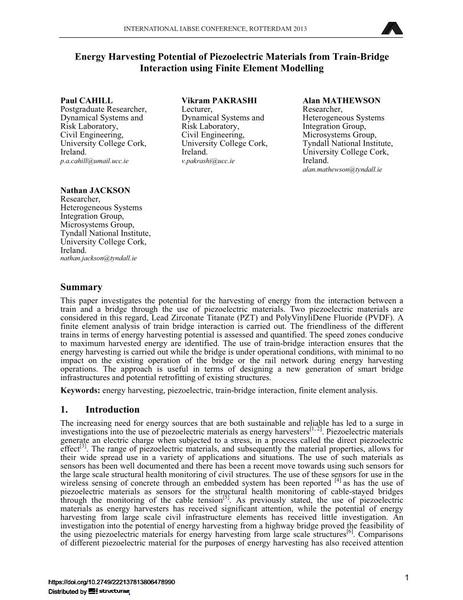Energy Harvesting Potential of Piezoelectric Materials from Train-Bridge Interaction using Finite Element Modelling

|
|
|||||||||||
Bibliographic Details
| Author(s): |
Paul Cahill
Vikram Pakrashi Alan Mathewson Nathan Jackson |
||||
|---|---|---|---|---|---|
| Medium: | conference paper | ||||
| Language(s): | English | ||||
| Conference: | IABSE Conference: Assessment, Upgrading and Refurbishment of Infrastructures, Rotterdam, The Netherlands, 6-8 May 2013 | ||||
| Published in: | IABSE Conference, Rotterdam, May 2013 | ||||
|
|||||
| Page(s): | 282-283 | ||||
| Total no. of pages: | 7 | ||||
| Year: | 2013 | ||||
| DOI: | 10.2749/222137813806478990 | ||||
| Abstract: |
This paper investigates the potential for the harvesting of energy from the interaction between a train and a bridge through the use of piezoelectric materials. Two piezoelectric materials are considered in this regard, Lead Zirconate Titanate (PZT) and PolyVinyliDene Fluoride (PVDF). A finite element analysis of train bridge interaction is carried out. The friendliness of the different trains in terms of energy harvesting potential is assessed and quantified. The speed zones conducive to maximum harvested energy are identified. The use of train-bridge interaction ensures that the energy harvesting is carried out while the bridge is under operational conditions, with minimal to no impact on the existing operation of the bridge or the rail network during energy harvesting operations. The approach is useful in terms of designing a new generation of smart bridge infrastructures and potential retrofitting of existing structures. |
||||
| Keywords: |
finite element analysis FEA energy harvesting Train-bridge interaction piezoelectric
|
||||
